People Management in NHS: Leadership, Training, and Talent
VerifiedAdded on 2023/01/13
|9
|2518
|29
Report
AI Summary
This report provides an in-depth analysis of people management within the National Health Service (NHS), focusing on three key areas: leadership and management, training and development, and talent management underpinning performance management. It explores applicable theoretical models such as situational leadership and classical management, recommending improvements in leadership skills, communication, and the implementation of effective training programs. The report also examines talent management through the lens of the integrated talent management model, offering recommendations for strategic planning, improved employee facilities, and the maintenance of a healthy work environment to enhance staff engagement and performance. The conclusion emphasizes the importance of aligning employee skills with their roles and continuously improving training and development programs to achieve better patient outcomes and organizational success within the NHS.
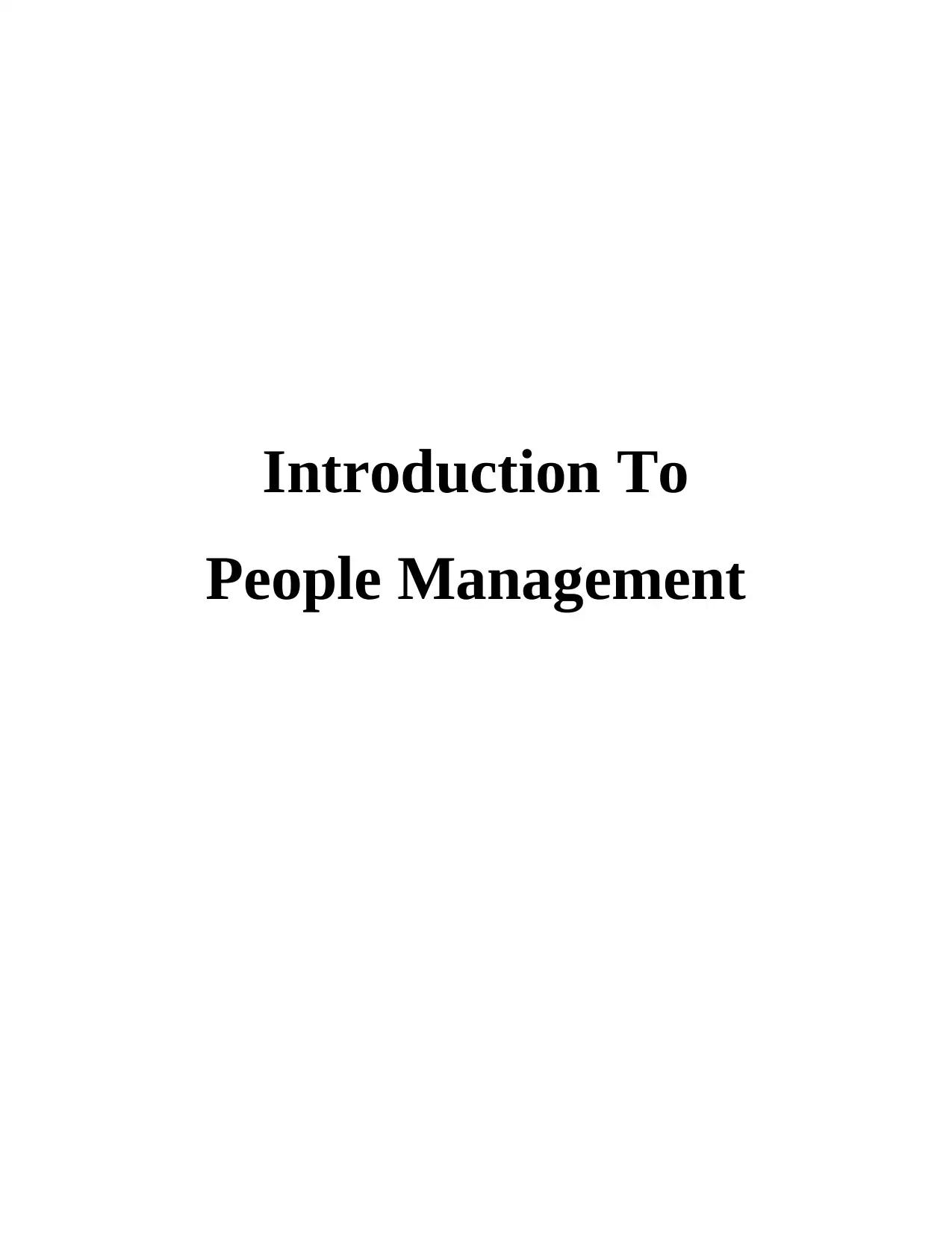
Introduction To
People Management
People Management
Paraphrase This Document
Need a fresh take? Get an instant paraphrase of this document with our AI Paraphraser
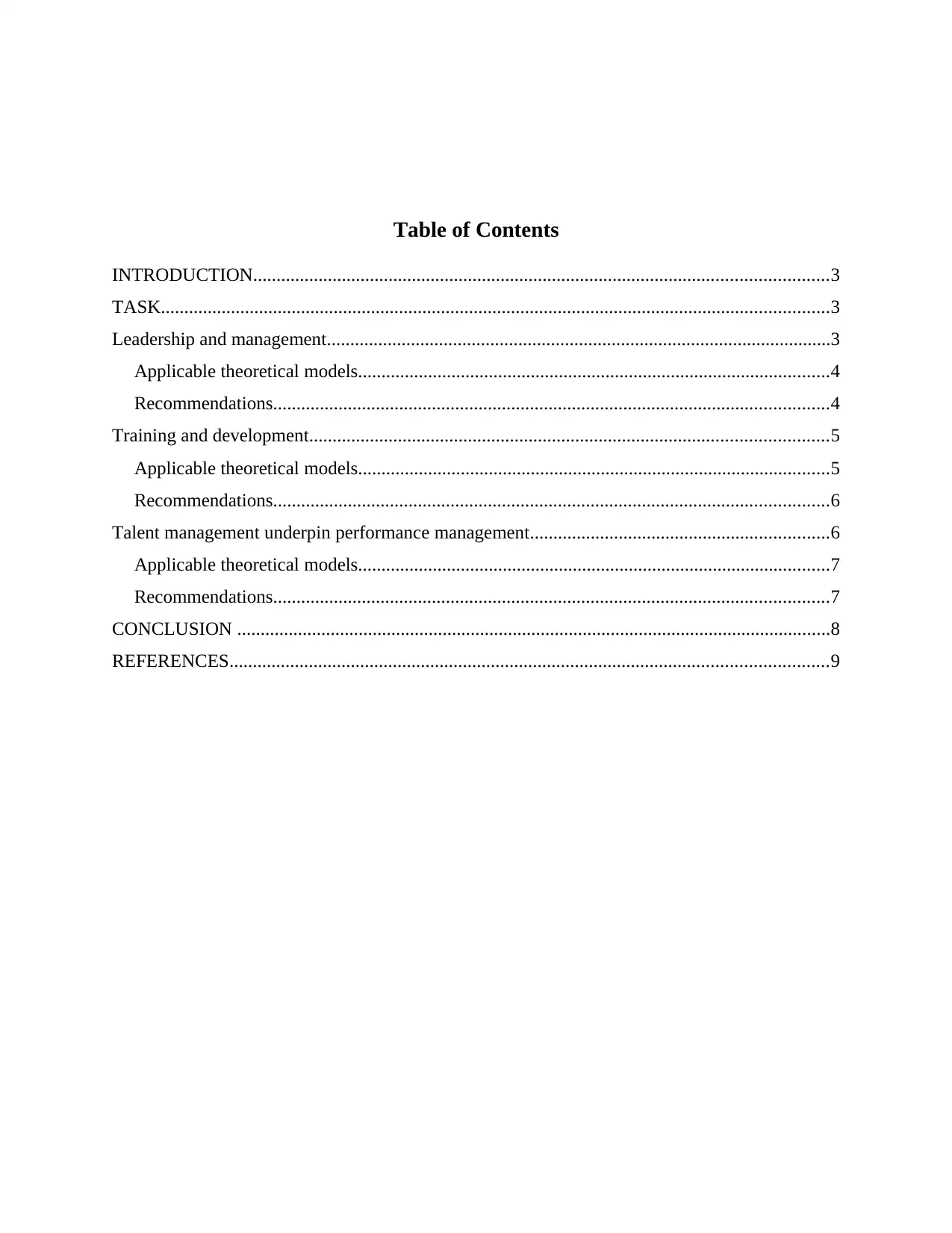
Table of Contents
INTRODUCTION...........................................................................................................................3
TASK...............................................................................................................................................3
Leadership and management............................................................................................................3
Applicable theoretical models.....................................................................................................4
Recommendations.......................................................................................................................4
Training and development...............................................................................................................5
Applicable theoretical models.....................................................................................................5
Recommendations.......................................................................................................................6
Talent management underpin performance management................................................................6
Applicable theoretical models.....................................................................................................7
Recommendations.......................................................................................................................7
CONCLUSION ...............................................................................................................................8
REFERENCES................................................................................................................................9
INTRODUCTION...........................................................................................................................3
TASK...............................................................................................................................................3
Leadership and management............................................................................................................3
Applicable theoretical models.....................................................................................................4
Recommendations.......................................................................................................................4
Training and development...............................................................................................................5
Applicable theoretical models.....................................................................................................5
Recommendations.......................................................................................................................6
Talent management underpin performance management................................................................6
Applicable theoretical models.....................................................................................................7
Recommendations.......................................................................................................................7
CONCLUSION ...............................................................................................................................8
REFERENCES................................................................................................................................9
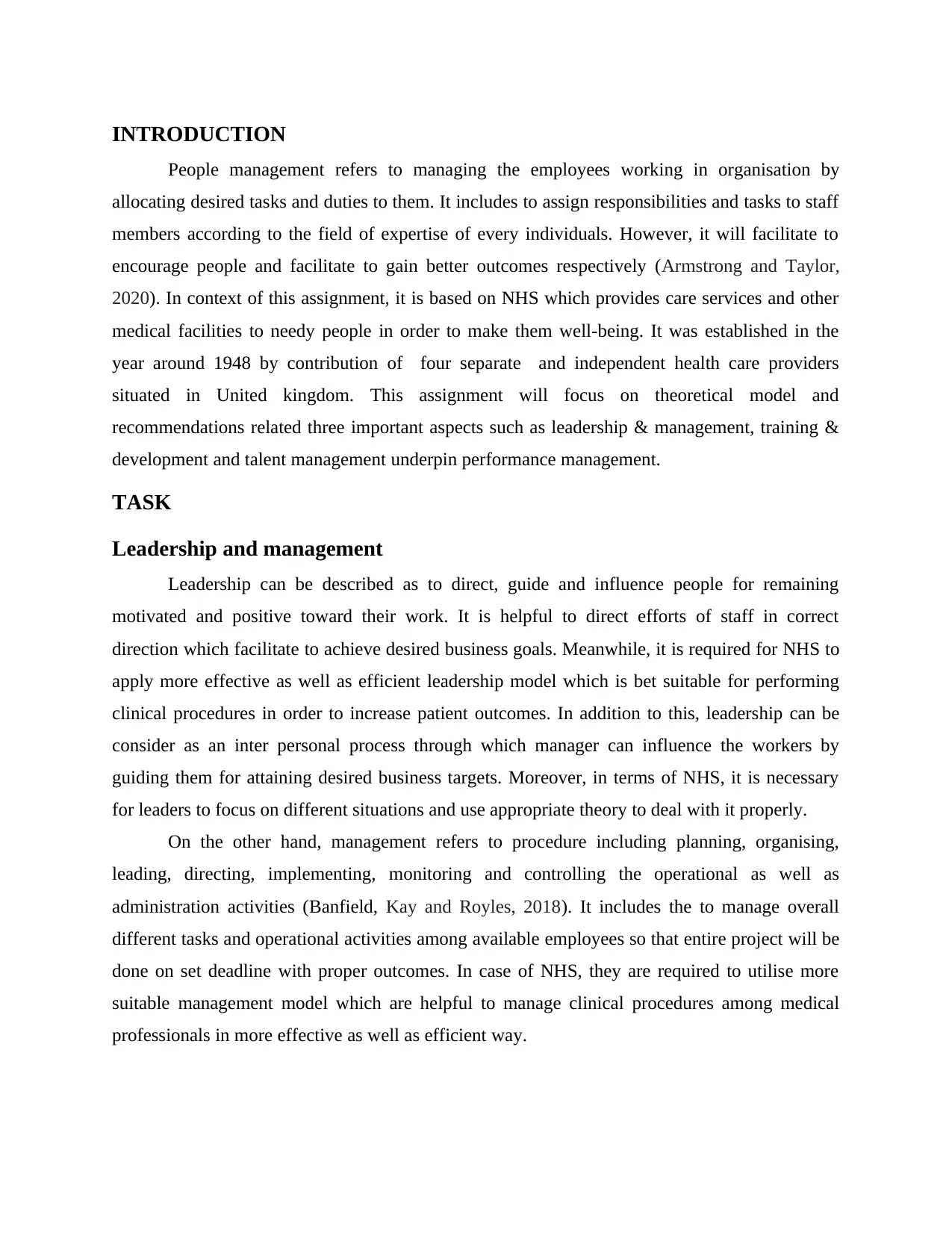
INTRODUCTION
People management refers to managing the employees working in organisation by
allocating desired tasks and duties to them. It includes to assign responsibilities and tasks to staff
members according to the field of expertise of every individuals. However, it will facilitate to
encourage people and facilitate to gain better outcomes respectively (Armstrong and Taylor,
2020). In context of this assignment, it is based on NHS which provides care services and other
medical facilities to needy people in order to make them well-being. It was established in the
year around 1948 by contribution of four separate and independent health care providers
situated in United kingdom. This assignment will focus on theoretical model and
recommendations related three important aspects such as leadership & management, training &
development and talent management underpin performance management.
TASK
Leadership and management
Leadership can be described as to direct, guide and influence people for remaining
motivated and positive toward their work. It is helpful to direct efforts of staff in correct
direction which facilitate to achieve desired business goals. Meanwhile, it is required for NHS to
apply more effective as well as efficient leadership model which is bet suitable for performing
clinical procedures in order to increase patient outcomes. In addition to this, leadership can be
consider as an inter personal process through which manager can influence the workers by
guiding them for attaining desired business targets. Moreover, in terms of NHS, it is necessary
for leaders to focus on different situations and use appropriate theory to deal with it properly.
On the other hand, management refers to procedure including planning, organising,
leading, directing, implementing, monitoring and controlling the operational as well as
administration activities (Banfield, Kay and Royles, 2018). It includes the to manage overall
different tasks and operational activities among available employees so that entire project will be
done on set deadline with proper outcomes. In case of NHS, they are required to utilise more
suitable management model which are helpful to manage clinical procedures among medical
professionals in more effective as well as efficient way.
People management refers to managing the employees working in organisation by
allocating desired tasks and duties to them. It includes to assign responsibilities and tasks to staff
members according to the field of expertise of every individuals. However, it will facilitate to
encourage people and facilitate to gain better outcomes respectively (Armstrong and Taylor,
2020). In context of this assignment, it is based on NHS which provides care services and other
medical facilities to needy people in order to make them well-being. It was established in the
year around 1948 by contribution of four separate and independent health care providers
situated in United kingdom. This assignment will focus on theoretical model and
recommendations related three important aspects such as leadership & management, training &
development and talent management underpin performance management.
TASK
Leadership and management
Leadership can be described as to direct, guide and influence people for remaining
motivated and positive toward their work. It is helpful to direct efforts of staff in correct
direction which facilitate to achieve desired business goals. Meanwhile, it is required for NHS to
apply more effective as well as efficient leadership model which is bet suitable for performing
clinical procedures in order to increase patient outcomes. In addition to this, leadership can be
consider as an inter personal process through which manager can influence the workers by
guiding them for attaining desired business targets. Moreover, in terms of NHS, it is necessary
for leaders to focus on different situations and use appropriate theory to deal with it properly.
On the other hand, management refers to procedure including planning, organising,
leading, directing, implementing, monitoring and controlling the operational as well as
administration activities (Banfield, Kay and Royles, 2018). It includes the to manage overall
different tasks and operational activities among available employees so that entire project will be
done on set deadline with proper outcomes. In case of NHS, they are required to utilise more
suitable management model which are helpful to manage clinical procedures among medical
professionals in more effective as well as efficient way.
⊘ This is a preview!⊘
Do you want full access?
Subscribe today to unlock all pages.

Trusted by 1+ million students worldwide
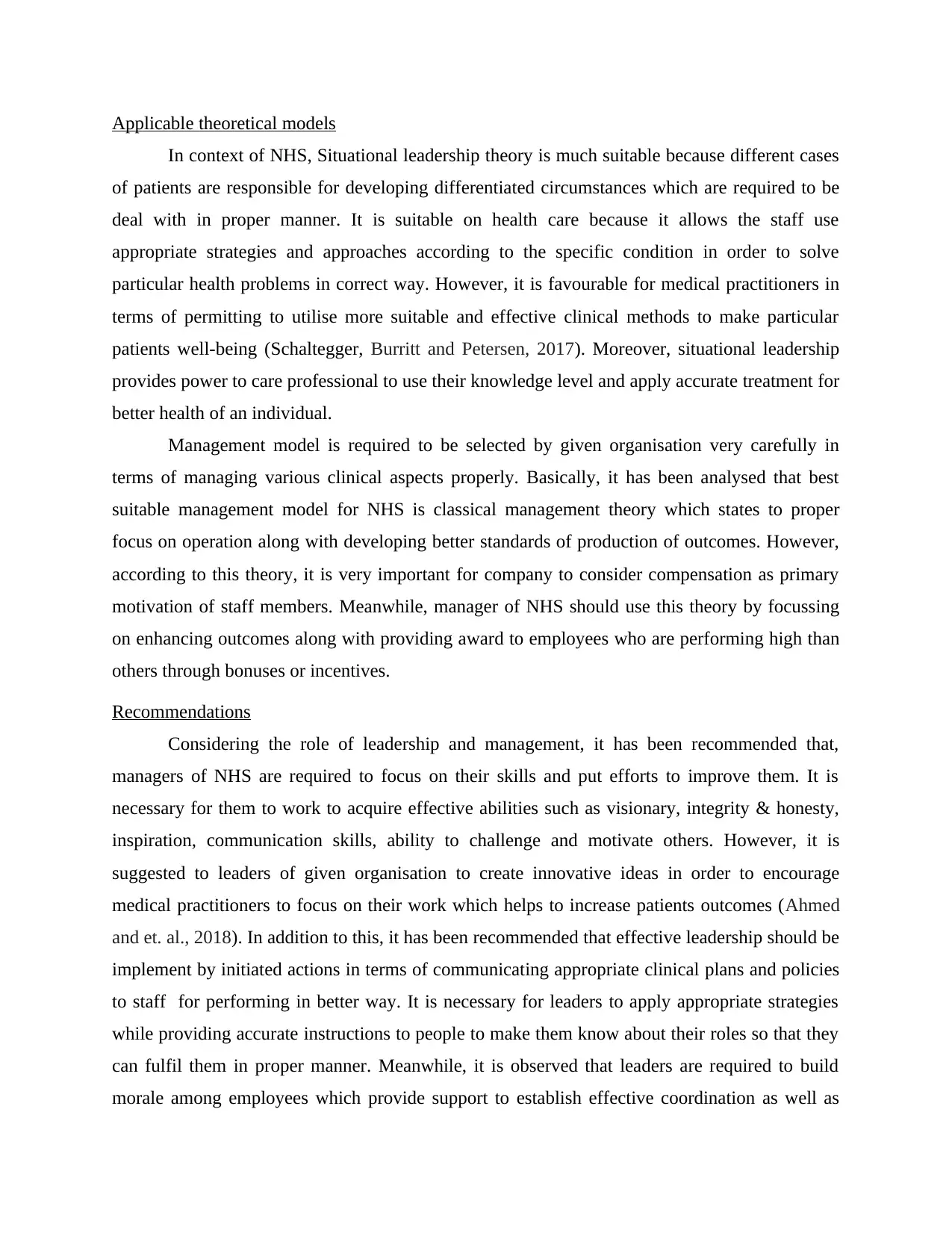
Applicable theoretical models
In context of NHS, Situational leadership theory is much suitable because different cases
of patients are responsible for developing differentiated circumstances which are required to be
deal with in proper manner. It is suitable on health care because it allows the staff use
appropriate strategies and approaches according to the specific condition in order to solve
particular health problems in correct way. However, it is favourable for medical practitioners in
terms of permitting to utilise more suitable and effective clinical methods to make particular
patients well-being (Schaltegger, Burritt and Petersen, 2017). Moreover, situational leadership
provides power to care professional to use their knowledge level and apply accurate treatment for
better health of an individual.
Management model is required to be selected by given organisation very carefully in
terms of managing various clinical aspects properly. Basically, it has been analysed that best
suitable management model for NHS is classical management theory which states to proper
focus on operation along with developing better standards of production of outcomes. However,
according to this theory, it is very important for company to consider compensation as primary
motivation of staff members. Meanwhile, manager of NHS should use this theory by focussing
on enhancing outcomes along with providing award to employees who are performing high than
others through bonuses or incentives.
Recommendations
Considering the role of leadership and management, it has been recommended that,
managers of NHS are required to focus on their skills and put efforts to improve them. It is
necessary for them to work to acquire effective abilities such as visionary, integrity & honesty,
inspiration, communication skills, ability to challenge and motivate others. However, it is
suggested to leaders of given organisation to create innovative ideas in order to encourage
medical practitioners to focus on their work which helps to increase patients outcomes (Ahmed
and et. al., 2018). In addition to this, it has been recommended that effective leadership should be
implement by initiated actions in terms of communicating appropriate clinical plans and policies
to staff for performing in better way. It is necessary for leaders to apply appropriate strategies
while providing accurate instructions to people to make them know about their roles so that they
can fulfil them in proper manner. Meanwhile, it is observed that leaders are required to build
morale among employees which provide support to establish effective coordination as well as
In context of NHS, Situational leadership theory is much suitable because different cases
of patients are responsible for developing differentiated circumstances which are required to be
deal with in proper manner. It is suitable on health care because it allows the staff use
appropriate strategies and approaches according to the specific condition in order to solve
particular health problems in correct way. However, it is favourable for medical practitioners in
terms of permitting to utilise more suitable and effective clinical methods to make particular
patients well-being (Schaltegger, Burritt and Petersen, 2017). Moreover, situational leadership
provides power to care professional to use their knowledge level and apply accurate treatment for
better health of an individual.
Management model is required to be selected by given organisation very carefully in
terms of managing various clinical aspects properly. Basically, it has been analysed that best
suitable management model for NHS is classical management theory which states to proper
focus on operation along with developing better standards of production of outcomes. However,
according to this theory, it is very important for company to consider compensation as primary
motivation of staff members. Meanwhile, manager of NHS should use this theory by focussing
on enhancing outcomes along with providing award to employees who are performing high than
others through bonuses or incentives.
Recommendations
Considering the role of leadership and management, it has been recommended that,
managers of NHS are required to focus on their skills and put efforts to improve them. It is
necessary for them to work to acquire effective abilities such as visionary, integrity & honesty,
inspiration, communication skills, ability to challenge and motivate others. However, it is
suggested to leaders of given organisation to create innovative ideas in order to encourage
medical practitioners to focus on their work which helps to increase patients outcomes (Ahmed
and et. al., 2018). In addition to this, it has been recommended that effective leadership should be
implement by initiated actions in terms of communicating appropriate clinical plans and policies
to staff for performing in better way. It is necessary for leaders to apply appropriate strategies
while providing accurate instructions to people to make them know about their roles so that they
can fulfil them in proper manner. Meanwhile, it is observed that leaders are required to build
morale among employees which provide support to establish effective coordination as well as
Paraphrase This Document
Need a fresh take? Get an instant paraphrase of this document with our AI Paraphraser
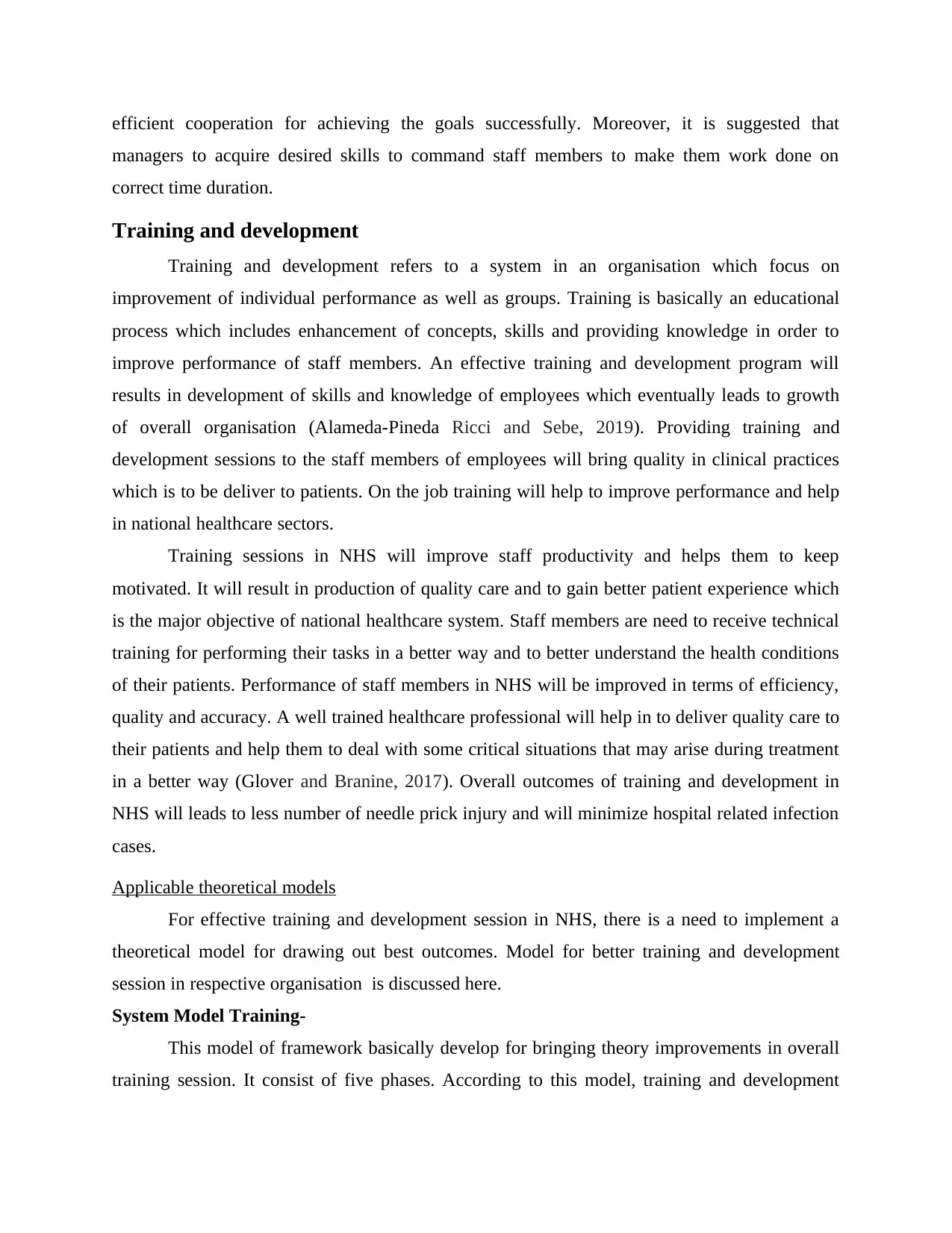
efficient cooperation for achieving the goals successfully. Moreover, it is suggested that
managers to acquire desired skills to command staff members to make them work done on
correct time duration.
Training and development
Training and development refers to a system in an organisation which focus on
improvement of individual performance as well as groups. Training is basically an educational
process which includes enhancement of concepts, skills and providing knowledge in order to
improve performance of staff members. An effective training and development program will
results in development of skills and knowledge of employees which eventually leads to growth
of overall organisation (Alameda-Pineda Ricci and Sebe, 2019). Providing training and
development sessions to the staff members of employees will bring quality in clinical practices
which is to be deliver to patients. On the job training will help to improve performance and help
in national healthcare sectors.
Training sessions in NHS will improve staff productivity and helps them to keep
motivated. It will result in production of quality care and to gain better patient experience which
is the major objective of national healthcare system. Staff members are need to receive technical
training for performing their tasks in a better way and to better understand the health conditions
of their patients. Performance of staff members in NHS will be improved in terms of efficiency,
quality and accuracy. A well trained healthcare professional will help in to deliver quality care to
their patients and help them to deal with some critical situations that may arise during treatment
in a better way (Glover and Branine, 2017). Overall outcomes of training and development in
NHS will leads to less number of needle prick injury and will minimize hospital related infection
cases.
Applicable theoretical models
For effective training and development session in NHS, there is a need to implement a
theoretical model for drawing out best outcomes. Model for better training and development
session in respective organisation is discussed here.
System Model Training-
This model of framework basically develop for bringing theory improvements in overall
training session. It consist of five phases. According to this model, training and development
managers to acquire desired skills to command staff members to make them work done on
correct time duration.
Training and development
Training and development refers to a system in an organisation which focus on
improvement of individual performance as well as groups. Training is basically an educational
process which includes enhancement of concepts, skills and providing knowledge in order to
improve performance of staff members. An effective training and development program will
results in development of skills and knowledge of employees which eventually leads to growth
of overall organisation (Alameda-Pineda Ricci and Sebe, 2019). Providing training and
development sessions to the staff members of employees will bring quality in clinical practices
which is to be deliver to patients. On the job training will help to improve performance and help
in national healthcare sectors.
Training sessions in NHS will improve staff productivity and helps them to keep
motivated. It will result in production of quality care and to gain better patient experience which
is the major objective of national healthcare system. Staff members are need to receive technical
training for performing their tasks in a better way and to better understand the health conditions
of their patients. Performance of staff members in NHS will be improved in terms of efficiency,
quality and accuracy. A well trained healthcare professional will help in to deliver quality care to
their patients and help them to deal with some critical situations that may arise during treatment
in a better way (Glover and Branine, 2017). Overall outcomes of training and development in
NHS will leads to less number of needle prick injury and will minimize hospital related infection
cases.
Applicable theoretical models
For effective training and development session in NHS, there is a need to implement a
theoretical model for drawing out best outcomes. Model for better training and development
session in respective organisation is discussed here.
System Model Training-
This model of framework basically develop for bringing theory improvements in overall
training session. It consist of five phases. According to this model, training and development
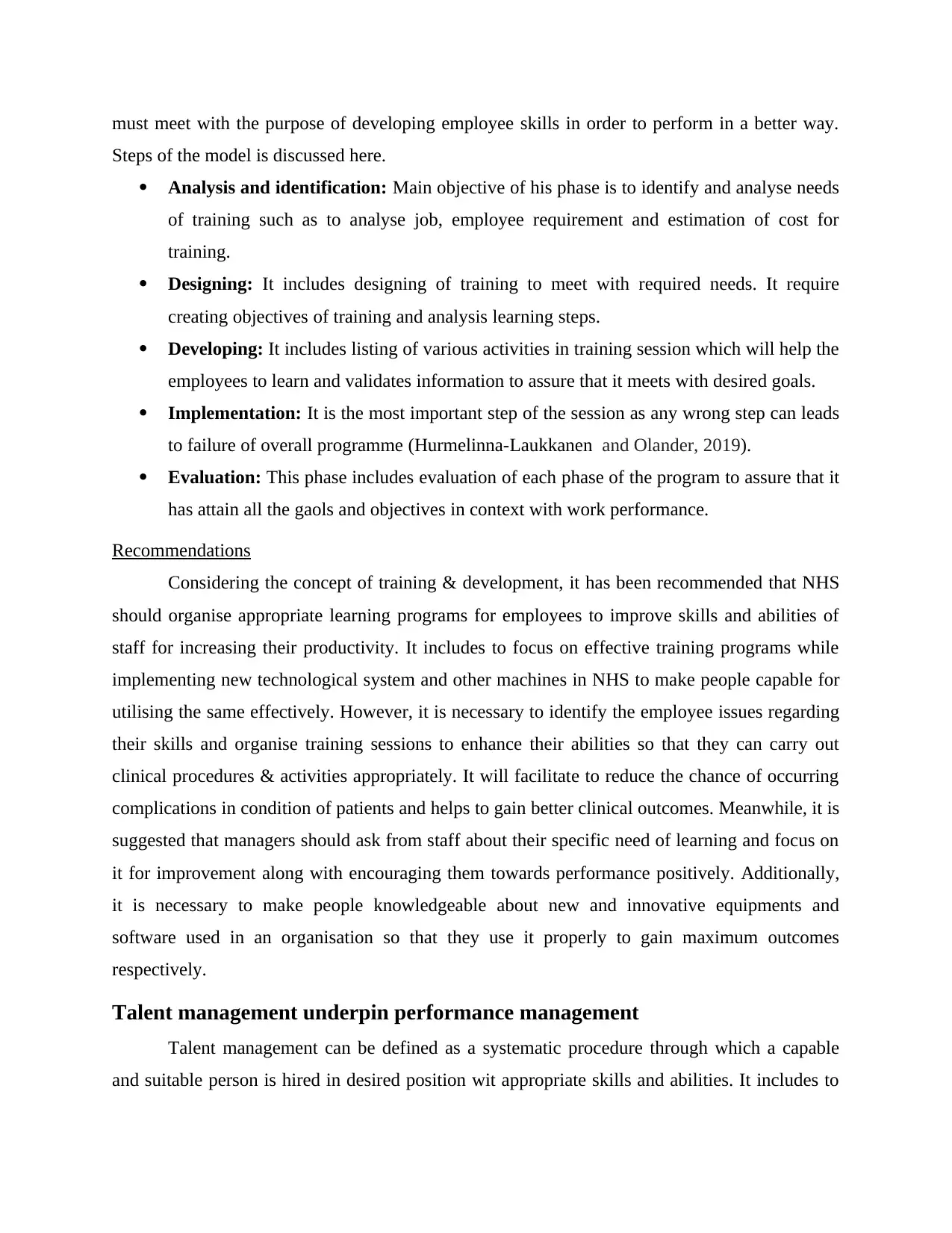
must meet with the purpose of developing employee skills in order to perform in a better way.
Steps of the model is discussed here.
Analysis and identification: Main objective of his phase is to identify and analyse needs
of training such as to analyse job, employee requirement and estimation of cost for
training.
Designing: It includes designing of training to meet with required needs. It require
creating objectives of training and analysis learning steps.
Developing: It includes listing of various activities in training session which will help the
employees to learn and validates information to assure that it meets with desired goals.
Implementation: It is the most important step of the session as any wrong step can leads
to failure of overall programme (Hurmelinna-Laukkanen and Olander, 2019).
Evaluation: This phase includes evaluation of each phase of the program to assure that it
has attain all the gaols and objectives in context with work performance.
Recommendations
Considering the concept of training & development, it has been recommended that NHS
should organise appropriate learning programs for employees to improve skills and abilities of
staff for increasing their productivity. It includes to focus on effective training programs while
implementing new technological system and other machines in NHS to make people capable for
utilising the same effectively. However, it is necessary to identify the employee issues regarding
their skills and organise training sessions to enhance their abilities so that they can carry out
clinical procedures & activities appropriately. It will facilitate to reduce the chance of occurring
complications in condition of patients and helps to gain better clinical outcomes. Meanwhile, it is
suggested that managers should ask from staff about their specific need of learning and focus on
it for improvement along with encouraging them towards performance positively. Additionally,
it is necessary to make people knowledgeable about new and innovative equipments and
software used in an organisation so that they use it properly to gain maximum outcomes
respectively.
Talent management underpin performance management
Talent management can be defined as a systematic procedure through which a capable
and suitable person is hired in desired position wit appropriate skills and abilities. It includes to
Steps of the model is discussed here.
Analysis and identification: Main objective of his phase is to identify and analyse needs
of training such as to analyse job, employee requirement and estimation of cost for
training.
Designing: It includes designing of training to meet with required needs. It require
creating objectives of training and analysis learning steps.
Developing: It includes listing of various activities in training session which will help the
employees to learn and validates information to assure that it meets with desired goals.
Implementation: It is the most important step of the session as any wrong step can leads
to failure of overall programme (Hurmelinna-Laukkanen and Olander, 2019).
Evaluation: This phase includes evaluation of each phase of the program to assure that it
has attain all the gaols and objectives in context with work performance.
Recommendations
Considering the concept of training & development, it has been recommended that NHS
should organise appropriate learning programs for employees to improve skills and abilities of
staff for increasing their productivity. It includes to focus on effective training programs while
implementing new technological system and other machines in NHS to make people capable for
utilising the same effectively. However, it is necessary to identify the employee issues regarding
their skills and organise training sessions to enhance their abilities so that they can carry out
clinical procedures & activities appropriately. It will facilitate to reduce the chance of occurring
complications in condition of patients and helps to gain better clinical outcomes. Meanwhile, it is
suggested that managers should ask from staff about their specific need of learning and focus on
it for improvement along with encouraging them towards performance positively. Additionally,
it is necessary to make people knowledgeable about new and innovative equipments and
software used in an organisation so that they use it properly to gain maximum outcomes
respectively.
Talent management underpin performance management
Talent management can be defined as a systematic procedure through which a capable
and suitable person is hired in desired position wit appropriate skills and abilities. It includes to
⊘ This is a preview!⊘
Do you want full access?
Subscribe today to unlock all pages.

Trusted by 1+ million students worldwide
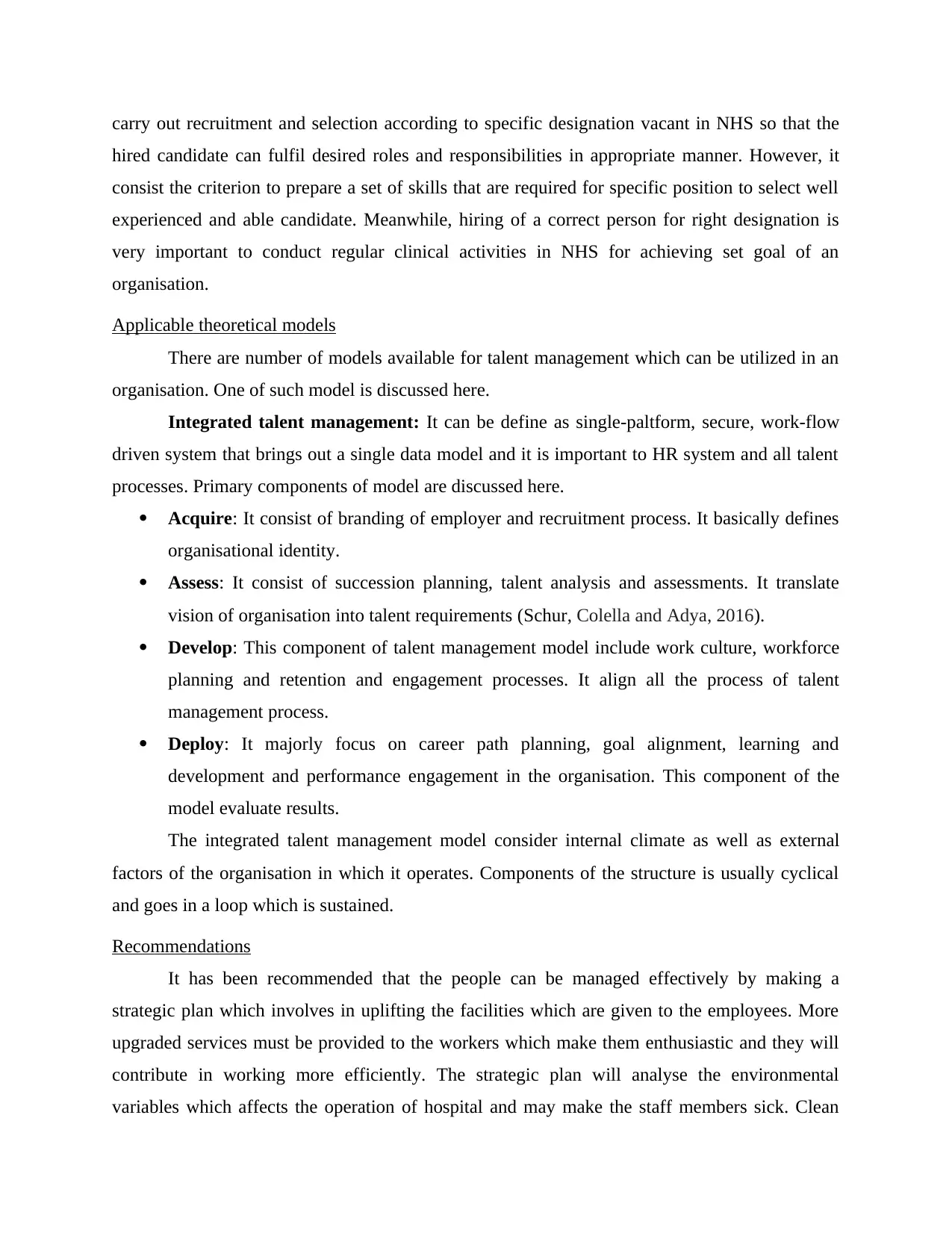
carry out recruitment and selection according to specific designation vacant in NHS so that the
hired candidate can fulfil desired roles and responsibilities in appropriate manner. However, it
consist the criterion to prepare a set of skills that are required for specific position to select well
experienced and able candidate. Meanwhile, hiring of a correct person for right designation is
very important to conduct regular clinical activities in NHS for achieving set goal of an
organisation.
Applicable theoretical models
There are number of models available for talent management which can be utilized in an
organisation. One of such model is discussed here.
Integrated talent management: It can be define as single-paltform, secure, work-flow
driven system that brings out a single data model and it is important to HR system and all talent
processes. Primary components of model are discussed here.
Acquire: It consist of branding of employer and recruitment process. It basically defines
organisational identity.
Assess: It consist of succession planning, talent analysis and assessments. It translate
vision of organisation into talent requirements (Schur, Colella and Adya, 2016).
Develop: This component of talent management model include work culture, workforce
planning and retention and engagement processes. It align all the process of talent
management process.
Deploy: It majorly focus on career path planning, goal alignment, learning and
development and performance engagement in the organisation. This component of the
model evaluate results.
The integrated talent management model consider internal climate as well as external
factors of the organisation in which it operates. Components of the structure is usually cyclical
and goes in a loop which is sustained.
Recommendations
It has been recommended that the people can be managed effectively by making a
strategic plan which involves in uplifting the facilities which are given to the employees. More
upgraded services must be provided to the workers which make them enthusiastic and they will
contribute in working more efficiently. The strategic plan will analyse the environmental
variables which affects the operation of hospital and may make the staff members sick. Clean
hired candidate can fulfil desired roles and responsibilities in appropriate manner. However, it
consist the criterion to prepare a set of skills that are required for specific position to select well
experienced and able candidate. Meanwhile, hiring of a correct person for right designation is
very important to conduct regular clinical activities in NHS for achieving set goal of an
organisation.
Applicable theoretical models
There are number of models available for talent management which can be utilized in an
organisation. One of such model is discussed here.
Integrated talent management: It can be define as single-paltform, secure, work-flow
driven system that brings out a single data model and it is important to HR system and all talent
processes. Primary components of model are discussed here.
Acquire: It consist of branding of employer and recruitment process. It basically defines
organisational identity.
Assess: It consist of succession planning, talent analysis and assessments. It translate
vision of organisation into talent requirements (Schur, Colella and Adya, 2016).
Develop: This component of talent management model include work culture, workforce
planning and retention and engagement processes. It align all the process of talent
management process.
Deploy: It majorly focus on career path planning, goal alignment, learning and
development and performance engagement in the organisation. This component of the
model evaluate results.
The integrated talent management model consider internal climate as well as external
factors of the organisation in which it operates. Components of the structure is usually cyclical
and goes in a loop which is sustained.
Recommendations
It has been recommended that the people can be managed effectively by making a
strategic plan which involves in uplifting the facilities which are given to the employees. More
upgraded services must be provided to the workers which make them enthusiastic and they will
contribute in working more efficiently. The strategic plan will analyse the environmental
variables which affects the operation of hospital and may make the staff members sick. Clean
Paraphrase This Document
Need a fresh take? Get an instant paraphrase of this document with our AI Paraphraser
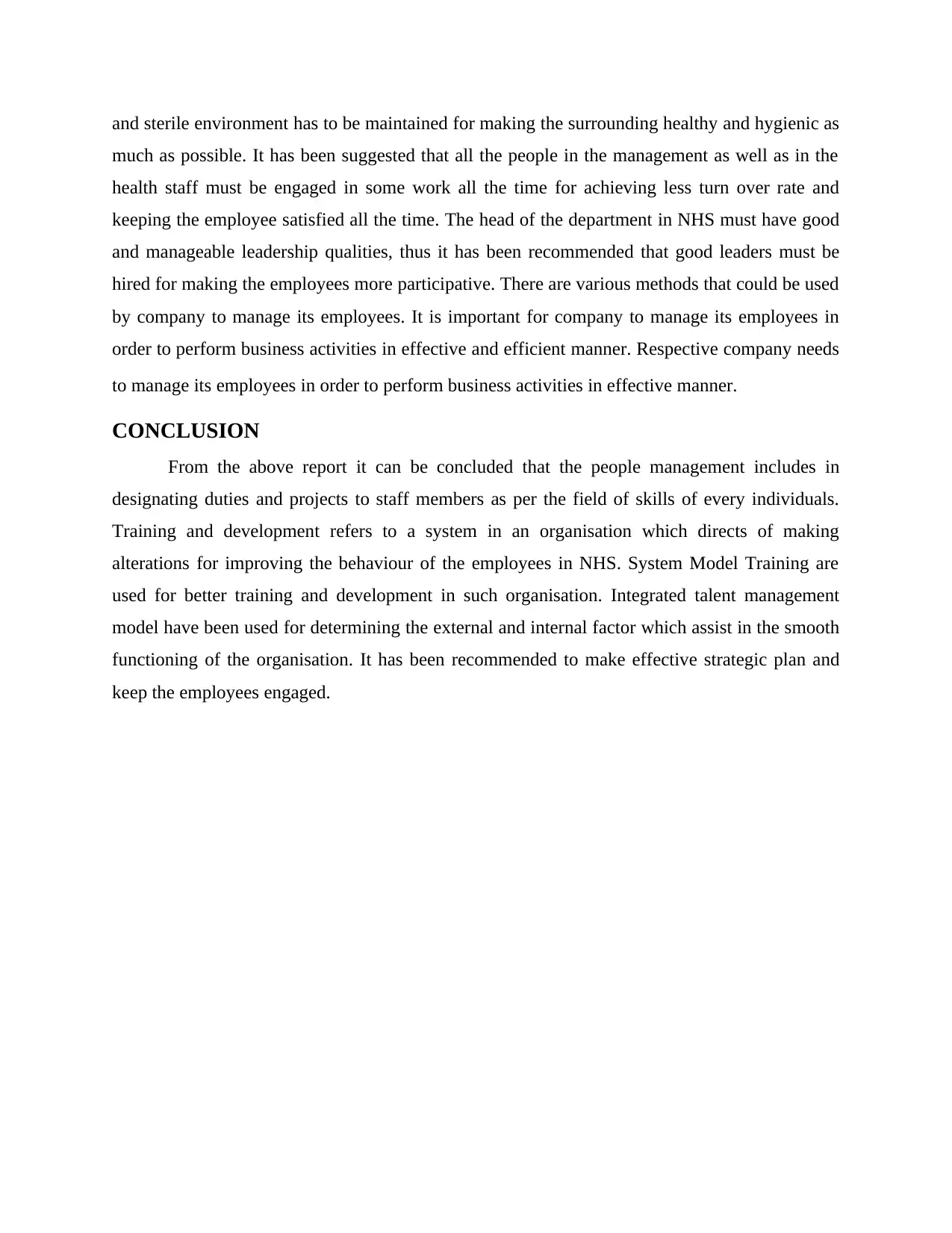
and sterile environment has to be maintained for making the surrounding healthy and hygienic as
much as possible. It has been suggested that all the people in the management as well as in the
health staff must be engaged in some work all the time for achieving less turn over rate and
keeping the employee satisfied all the time. The head of the department in NHS must have good
and manageable leadership qualities, thus it has been recommended that good leaders must be
hired for making the employees more participative. There are various methods that could be used
by company to manage its employees. It is important for company to manage its employees in
order to perform business activities in effective and efficient manner. Respective company needs
to manage its employees in order to perform business activities in effective manner.
CONCLUSION
From the above report it can be concluded that the people management includes in
designating duties and projects to staff members as per the field of skills of every individuals.
Training and development refers to a system in an organisation which directs of making
alterations for improving the behaviour of the employees in NHS. System Model Training are
used for better training and development in such organisation. Integrated talent management
model have been used for determining the external and internal factor which assist in the smooth
functioning of the organisation. It has been recommended to make effective strategic plan and
keep the employees engaged.
much as possible. It has been suggested that all the people in the management as well as in the
health staff must be engaged in some work all the time for achieving less turn over rate and
keeping the employee satisfied all the time. The head of the department in NHS must have good
and manageable leadership qualities, thus it has been recommended that good leaders must be
hired for making the employees more participative. There are various methods that could be used
by company to manage its employees. It is important for company to manage its employees in
order to perform business activities in effective and efficient manner. Respective company needs
to manage its employees in order to perform business activities in effective manner.
CONCLUSION
From the above report it can be concluded that the people management includes in
designating duties and projects to staff members as per the field of skills of every individuals.
Training and development refers to a system in an organisation which directs of making
alterations for improving the behaviour of the employees in NHS. System Model Training are
used for better training and development in such organisation. Integrated talent management
model have been used for determining the external and internal factor which assist in the smooth
functioning of the organisation. It has been recommended to make effective strategic plan and
keep the employees engaged.
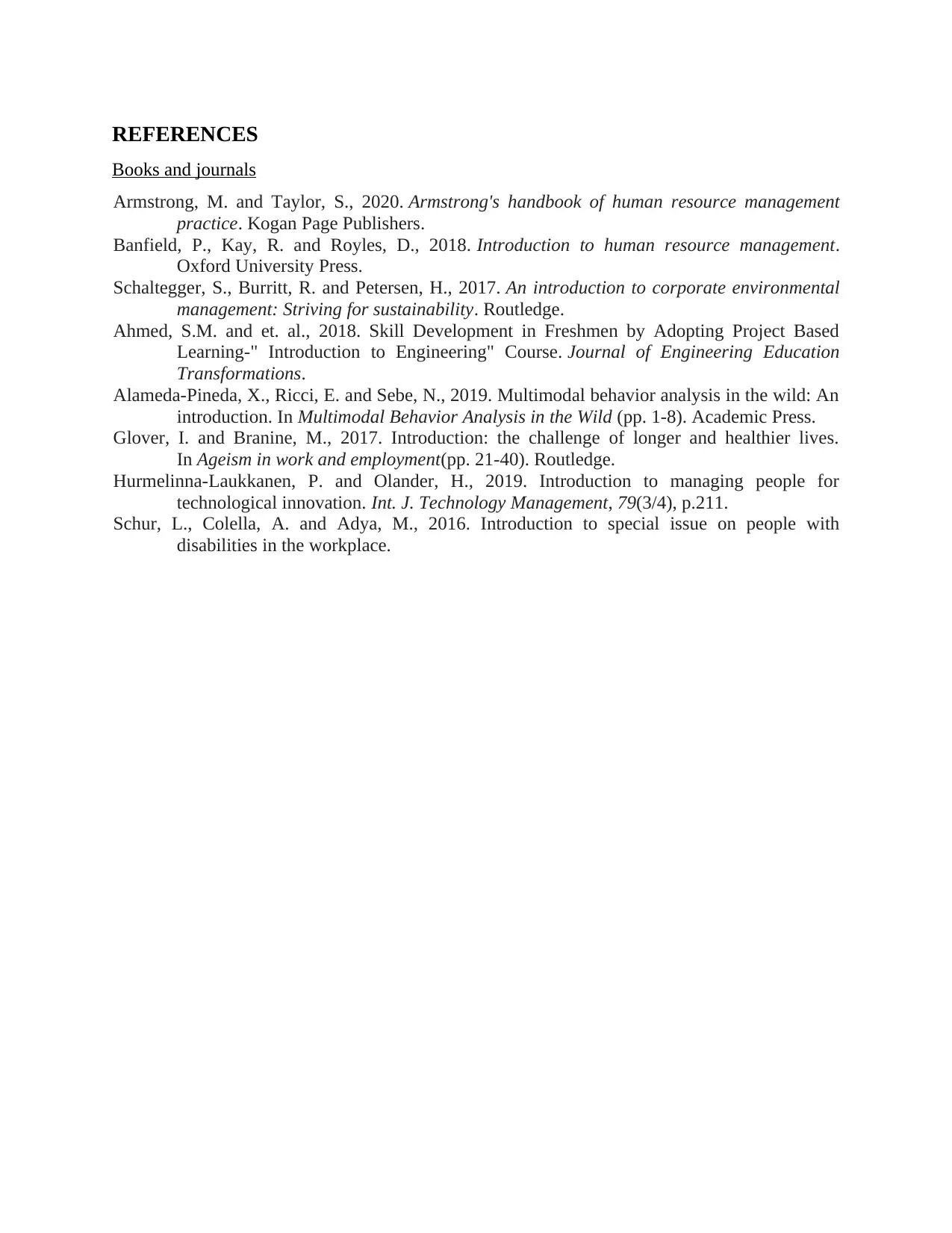
REFERENCES
Books and journals
Armstrong, M. and Taylor, S., 2020. Armstrong's handbook of human resource management
practice. Kogan Page Publishers.
Banfield, P., Kay, R. and Royles, D., 2018. Introduction to human resource management.
Oxford University Press.
Schaltegger, S., Burritt, R. and Petersen, H., 2017. An introduction to corporate environmental
management: Striving for sustainability. Routledge.
Ahmed, S.M. and et. al., 2018. Skill Development in Freshmen by Adopting Project Based
Learning-" Introduction to Engineering" Course. Journal of Engineering Education
Transformations.
Alameda-Pineda, X., Ricci, E. and Sebe, N., 2019. Multimodal behavior analysis in the wild: An
introduction. In Multimodal Behavior Analysis in the Wild (pp. 1-8). Academic Press.
Glover, I. and Branine, M., 2017. Introduction: the challenge of longer and healthier lives.
In Ageism in work and employment(pp. 21-40). Routledge.
Hurmelinna-Laukkanen, P. and Olander, H., 2019. Introduction to managing people for
technological innovation. Int. J. Technology Management, 79(3/4), p.211.
Schur, L., Colella, A. and Adya, M., 2016. Introduction to special issue on people with
disabilities in the workplace.
Books and journals
Armstrong, M. and Taylor, S., 2020. Armstrong's handbook of human resource management
practice. Kogan Page Publishers.
Banfield, P., Kay, R. and Royles, D., 2018. Introduction to human resource management.
Oxford University Press.
Schaltegger, S., Burritt, R. and Petersen, H., 2017. An introduction to corporate environmental
management: Striving for sustainability. Routledge.
Ahmed, S.M. and et. al., 2018. Skill Development in Freshmen by Adopting Project Based
Learning-" Introduction to Engineering" Course. Journal of Engineering Education
Transformations.
Alameda-Pineda, X., Ricci, E. and Sebe, N., 2019. Multimodal behavior analysis in the wild: An
introduction. In Multimodal Behavior Analysis in the Wild (pp. 1-8). Academic Press.
Glover, I. and Branine, M., 2017. Introduction: the challenge of longer and healthier lives.
In Ageism in work and employment(pp. 21-40). Routledge.
Hurmelinna-Laukkanen, P. and Olander, H., 2019. Introduction to managing people for
technological innovation. Int. J. Technology Management, 79(3/4), p.211.
Schur, L., Colella, A. and Adya, M., 2016. Introduction to special issue on people with
disabilities in the workplace.
⊘ This is a preview!⊘
Do you want full access?
Subscribe today to unlock all pages.

Trusted by 1+ million students worldwide
1 out of 9
Related Documents
Your All-in-One AI-Powered Toolkit for Academic Success.
+13062052269
info@desklib.com
Available 24*7 on WhatsApp / Email
![[object Object]](/_next/static/media/star-bottom.7253800d.svg)
Unlock your academic potential
Copyright © 2020–2025 A2Z Services. All Rights Reserved. Developed and managed by ZUCOL.





